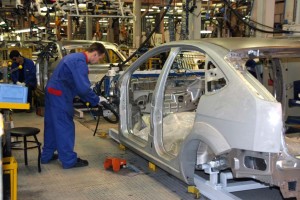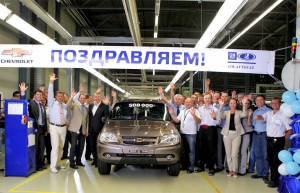
Ford is hunkering down for the long haul in Russia while GM is cutting back its operations while the market there continues its free fall.
Facing the prospect of a collapsing local market, Ford Motor Co. is looking with increased desperation for ways to keep its Russian assembly plants busy. It hopes to avoid the same fate as rival General Motors, which has chosen to all but abandon the Russian market entirely.
The heart of the former Soviet Union has seen its car market plunge by 30% since the beginning of this year as Western sanctions have taken hold. And that’s on top of the sharp decline Russia experienced in 2014, sales now running barely half the market’s one-time peak of around 3 million vehicles a year.
But Russia isn’t alone. In fact, only India has continued to maintain solid, positive momentum among the so-called BRIC countries — which also include Brazil, India and China — the most promising emerging markets that were supposed to deliver most of the growth for the global auto industry in the years ahead.
The Russian market has suffered the worst fate of the four due to a combination of factors. Its economy has been hit hard as a result of the downturn in global oil prices, Russia one of the largest of the non-OPEC producers. And then there have been the sanctions imposed by the U.S. and Europe in the wake of the Russian annexation of the Crimea and its support for Ukranian separatists.
Russian car sales are expected to end the year at less than 1.6 million, according to Mark Ovenden, president and CEO of Ford Sollers, the Detroit maker’s joint venture which operates several plants, including one in St. Petersburg. Last year, demand was 2.5 million, and Russian car sales peaked before the crisis at around 3 million.

Hello, we must be going. A GM Niva rolls down the Avtovaz assembly line. Plans for an updated car have been scrubbed.
Last March, GM announced it was shuttering its own Russian plants, and it will only continue offering a handful of imported Chevrolet products in the market by the end of this year, GM President Dan Ammann citing Russia’s “very challenging long-term prospects.”
Ford isn’t looking to pull out, however, Ovenden telling Reuters the partnership that “Export is something we’re looking at.”
(Ford faces SEC probe over possible bribes of Russian officials. For more, Click Here.)
With the ruble having suffered a major decline in value in recent years, it makes it more viable to ship products from Ford plants to other markets. It certainly needs to find some opportunity. Ford sold only 30,500 cars in Russia through the end of October, its plants there capable of producing 350,000 vehicles annually.
Automakers are being forced to rethink their strategies in two other members of the BRIC group. Brazil’s car market – along with consumer confidence – has gone into freefall. The situation reflects a sharp plunge in the economy of Latin America’s most populous nation, compounded by the crisis touched off by a bribery scandal that threatens to topple Brazil’s president who know faces the threat of impeachment.
Perhaps the biggest surprise among the four countries was the sharp slowdown this year in Chinese car sales. Demand actually dipped, year-over-year, for several months, raising doubts China could even maintain the modest 7% car sales growth once forecast. Since the beginning of the new millennium, sales had steadily grown at a double-digit clip, sometimes approaching 100% annually.
November brought some improvement, however, and signs that the downturn is temporary. But even that brief scare is raising questions about the billions of dollars automakers have committed to new Chinese plants. One solution appears to echo the Russian model.
(Click Here for details about auto sales in Russia.)
For more than a decade, most makers have said they don’t have the capacity left to even consider exporting cars from China. But now, two Western brands are testing the waters. Volvo has begun exporting a stretched version of its S60 sedan, dubbed the Inscription, to the United States. Buick is set to follow with a compact crossover, the Buick Envision.
Other makers are expected to watch and see how American buyers react – and whether the move triggers any political backlash as the U.S. approaches the November 2016 presidential election.
China does appear to still be growing fast in at least one significant market segment this year. Buyers there are being nudged by the Beijing government to switch to electric vehicles to help deal with endemic smog problems. In a number of cities they get to sidestep monthly registration limits on conventional gas-powered vehicles. And so, notes the Economic Times, demand for battery-based vehicles should top that of the U.S., at between 225,000 to 250,000, for the first time.
(To see more about GM’s decision to slash its presence in Russia, Click Here.)
Among the BRICs, only one market seems to be living up to its potential, India. Sales have been among the world’s fastest-growing this year, but even so, demand has been somewhat erratic in recent months, adding to the industry’s overall concern, analysts note. And sales have been largely dominated by just a small number of makers, such as Maruti Suzuki, leaving the rest of the industry to fight over the scraps.

I will not buy any car or truck.Unless its Built in Canada or the USA. Because I know what im buying. Quality. if they keep building in so so many other countys . there will be no work for USA, AND OR Canada, Workers. putting a Lot of Familys into Finachal Trouble. so just keep the jobs here in USA, And Canada. Thank You. they do a much better job. and can get parts faster when I need them. Thank You Again. Franco.
Most CEOs do not care about U.S. workers, they care about their multi-million dollar annual bonuses on top of their multi-million dollar base compensation. It’s all about financial greed.